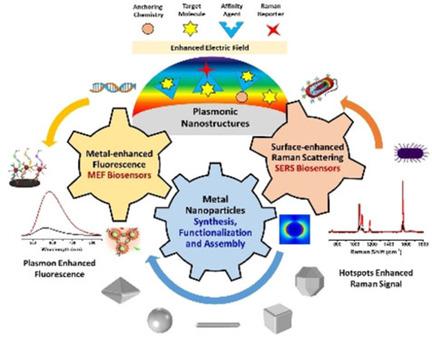当前位置:
X-MOL 学术
›
Chem. Asian J.
›
论文详情
Our official English website, www.x-mol.net, welcomes your
feedback! (Note: you will need to create a separate account there.)
Metal Nanoparticles-Enhanced Biosensors: Synthesis, Design and Applications in Fluorescence Enhancement and Surface-enhanced Raman Scattering.
Chemistry - An Asian Journal ( IF 3.5 ) Pub Date : 2020-08-18 , DOI: 10.1002/asia.202000847 Mohammad Tavakkoli Yaraki 1 , Yen Nee Tan 2, 3
Chemistry - An Asian Journal ( IF 3.5 ) Pub Date : 2020-08-18 , DOI: 10.1002/asia.202000847 Mohammad Tavakkoli Yaraki 1 , Yen Nee Tan 2, 3
Affiliation

|
Metal nanoparticles (NP) that exhibit localized surface plasmon resonance play an important role in metal‐enhanced fluorescence (MEF) and surface‐enhanced Raman scattering (SERS). Among the optical biosensors, MEF and SERS stand out to be the most sensitive techniques to detect a wide range of analytes from ions, biomolecules to macromolecules and microorganisms. Particularly, anisotropic metal NPs with strongly enhanced electric field at their sharp corners/edges under a wide range of excitation wavelengths are highly suitable for developing the ultrasensitive plasmon‐enhanced biosensors. In this review, we first highlight the reliable methods for the synthesis of anisotropic gold NPs and silver NPs in high yield, as well as their alloys and composites with good control of size and shape. It is followed by the discussion of different sensing mechanisms and recent advances in the MEF and SERS biosensor designs. This includes the review of surface functionalization, bioconjugation and (directed/self) assembly methods as well as the selection/screening of specific biorecognition elements such as aptamers or antibodies for the highly selective bio‐detection. The right combinations of metal nanoparticles, biorecognition element and assay design will lead to the successful development of MEF and SERS biosensors targeting different analytes both in‐vitro and in‐vivo. Finally, the prospects and challenges of metal‐enhanced biosensors for future nanomedicine in achieving ultrasensitive and fast medical diagnostics, high‐throughput drug discovery as well as effective and reliable theranostic treatment are discussed.
中文翻译:

金属纳米颗粒增强生物传感器:荧光增强和表面增强拉曼散射的合成、设计和应用。
表现出局域表面等离子体共振的金属纳米颗粒(NP)在金属增强荧光(MEF)和表面增强拉曼散射(SERS)中发挥着重要作用。在光学生物传感器中,MEF 和 SERS 脱颖而出,是检测从离子、生物分子到大分子和微生物等各种分析物的最灵敏的技术。特别是,在宽范围的激发波长下,各向异性金属纳米颗粒的尖角/边缘处具有强烈增强的电场,非常适合开发超灵敏的等离子体增强生物传感器。在这篇综述中,我们首先重点介绍了高产率合成各向异性金纳米颗粒和银纳米颗粒的可靠方法,以及它们的合金和复合材料,它们具有良好的尺寸和形状控制。接下来讨论不同的传感机制以及 MEF 和 SERS 生物传感器设计的最新进展。这包括对表面功能化、生物共轭和(定向/自)组装方法的审查,以及用于高选择性生物检测的特定生物识别元件(例如适体或抗体)的选择/筛选。金属纳米颗粒、生物识别元件和检测设计的正确组合将导致针对不同体外和体内分析物的 MEF 和 SERS 生物传感器的成功开发。最后,讨论了金属增强生物传感器在未来纳米医学中实现超灵敏和快速医学诊断、高通量药物发现以及有效和可靠的治疗诊断治疗的前景和挑战。
更新日期:2020-10-17
中文翻译:

金属纳米颗粒增强生物传感器:荧光增强和表面增强拉曼散射的合成、设计和应用。
表现出局域表面等离子体共振的金属纳米颗粒(NP)在金属增强荧光(MEF)和表面增强拉曼散射(SERS)中发挥着重要作用。在光学生物传感器中,MEF 和 SERS 脱颖而出,是检测从离子、生物分子到大分子和微生物等各种分析物的最灵敏的技术。特别是,在宽范围的激发波长下,各向异性金属纳米颗粒的尖角/边缘处具有强烈增强的电场,非常适合开发超灵敏的等离子体增强生物传感器。在这篇综述中,我们首先重点介绍了高产率合成各向异性金纳米颗粒和银纳米颗粒的可靠方法,以及它们的合金和复合材料,它们具有良好的尺寸和形状控制。接下来讨论不同的传感机制以及 MEF 和 SERS 生物传感器设计的最新进展。这包括对表面功能化、生物共轭和(定向/自)组装方法的审查,以及用于高选择性生物检测的特定生物识别元件(例如适体或抗体)的选择/筛选。金属纳米颗粒、生物识别元件和检测设计的正确组合将导致针对不同体外和体内分析物的 MEF 和 SERS 生物传感器的成功开发。最后,讨论了金属增强生物传感器在未来纳米医学中实现超灵敏和快速医学诊断、高通量药物发现以及有效和可靠的治疗诊断治疗的前景和挑战。










































 京公网安备 11010802027423号
京公网安备 11010802027423号